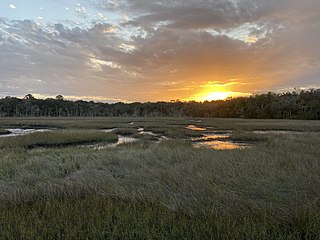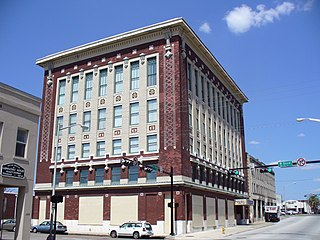
Jacksonville is a city located on the Atlantic coast of Florida, the most populous city in the state, and is the largest city by area in the contiguous United States as of 2020. It is the seat of Duval County, with which the city government consolidated in 1968. Consolidation gave Jacksonville its great size and placed most of its metropolitan population within the city limits. As of 2020, Jacksonville's population is 949,611, making it the 12th most populous city in the U.S., the most populous city in the Southeast, and the most populous city in the South outside of the state of Texas. With a population of 1,733,937, the Jacksonville metropolitan area ranks as Florida's fourth-largest metropolitan region.

The city of Jacksonville, Florida began to grow in the late 18th century as Cow Ford, settled by British colonists. Its major development occurred in the late nineteenth century, when it became a winter vacation destination for tourists from the North and Midwest. Its development was halted or slowed by the Great Fire of 1901, the Florida Land Bust of the 1920s, and the economic woes of the 1960s and 70s. Since the late 20th century, the city has experienced steady growth, with a new federal building constructed in downtown in 2003.

The Timucuan Ecological and Historic Preserve is a U.S. National Preserve in Jacksonville, Florida. It comprises 46,000 acres (19,000 ha) of wetlands, waterways, and other habitats in northeastern Duval County. Managed by the National Park Service in cooperation with the City of Jacksonville and Florida State Parks, it includes natural and historic areas such as the Fort Caroline National Memorial and the Kingsley Plantation.

Fort Cooper State Park is a 710-acre historic site in Inverness, Florida, United States. It is located two miles (3 km) south of Inverness, off of U.S. Hwy. 41 on South Old Floral City Road. On June 13, 1972, it was added to the United States National Register of Historic Places. It is also a Florida State Park.

Ortega is a neighborhood of Jacksonville, Florida, US. It is located south of downtown Jacksonville on a peninsula off the western bank of the St. Johns River. It is one of the wealthiest neighborhoods in Jacksonville, and is the location of many historic homes and buildings.

Maple Leaf is a United States National Historic Landmark in Jacksonville, Florida, United States. Maple Leaf, a side paddlewheel steamship, was first launched as a freight and passenger vessel from the Marine Railway Yard in Kingston, Upper Canada in 1851. The 181-foot (55 m) sidewheel paddle steamer measured 24.7-foot (7.5 m) at the beam.

The Masonic Temple is a historic Masonic temple in Jacksonville, Florida. It is located at 410 Broad Street. Constructed by the Grand Lodge between 1901 and 1912, it was added to the U.S. National Register of Historic Places on September 22, 1980.

Saint George Episcopal Church is an historic Carpenter Gothic style Episcopal church located at 10560 East Fort George Road on Fort George Island in Jacksonville, Florida in the United States. Built in 1882–1883, it was designed by architect Robert S. Schuyler of nearby Fernandina.

The Henry John Klutho House is a historic home in Jacksonville, Florida. The house was designed and lived in by the New York City architect Henry John Klutho, who helped in the rebuilding of Jacksonville after the Great Fire of 1901. It is located at 28-30 West 9th Street. On December 19, 1978, it was added to the U.S. National Register of Historic Places.

The John S. Sammis House is a historic home in Jacksonville, Florida. It is located at 207 Noble Circle West. On July 10, 1979, it was added to the U.S. National Register of Historic Places.

The Ribault Club is an historic building on Fort George Island near Jacksonville, Florida. It is now home to the Fort George Island Visitor Center. The building was designed in a Colonial Revival architecture style and is credited to Maurice Fatio and Mellen Clark Greeley. It was added to the U.S. National Register of Historic Places on May 11, 2000, and is located on Fort George Road. It was built in 1928 for winter recreation and is considered a legacy of Fort George Island's resort era. Winter recreational opportunities included golf, tennis, hunting, fishing, and yachting. The building is listed as a Historic Landmark by the City of Jacksonville. It became part of the Fort George Island Cultural State Park in 1989.

The former St. Andrew's Episcopal Church building, also known as Old St. Andrew's Event Venue, is an historic building located at 317 Florida Avenue in downtown Jacksonville, Florida. It was originally an Episcopal church, but closed when the parish relocated to the suburbs in 1960. On May 4, 1976, the edifice was added to the U.S. National Register of Historic Places. In the 1990s it was purchased by the City of Jacksonville and turned over to the Jacksonville Historical Society (JHS), and now serves as an event venue managed by the society.

The Battle of St. John's Bluff was fought from October 1–3, 1862, between Union and Confederate forces in Duval County, Florida, during the American Civil War. The battle resulted in a significant Union victory, helping secure their control of the Jacksonville area.

Theatre Jacksonville is a community theatre based in Jacksonville, Florida, United States. One of the oldest continually producing community theatres in the United States, its building, also known as the Little Theatre, was added to the National Register of Historic Places in 1991.

The following is an alphabetical list of articles related to the U.S. state of Florida.

North Florida is a region of the U.S. state of Florida comprising the northernmost part of the state. Along with South Florida and Central Florida, it is one of Florida's three most common "directional" regions. It includes Jacksonville and nearby localities in Northeast Florida, an interior region known as North Central Florida, and the Florida Panhandle.

Riverside and Avondale are two adjacent and closely associated neighborhoods, alternatively considered one continuous neighborhood, of Jacksonville, Florida. The area is primarily residential, but includes some commercial districts, including Five Points, the King Street District, and the Shoppes of Avondale.

The Northside is a large region of Jacksonville, Florida, and is generally understood as a counterpart to the city's other large regions, the Urban Core, Arlington, Southside, Westside, and the Beaches. The expansive area consists of historic communities, cultural landmarks, protected ecosystems and vital transportation and logistics facilities, all fundamental to the history and development of Jacksonville.























